The Jolly Roger Bar, 12th and Madison. Oil on board, 12 x 16″
As you know, I’ve been painting around Portland, here and there, returning often to sites to note what else is there, what I may have missed, what more is available for turning into paint.
These paintings have a certain “feel” to them — a style that fits with the record of my visits. I work on-site and then tweak and fiddle in the studio. I also find myself making larger, stranger, studio-begot contributions to the sets of pieces.
I have already exposed the Fremont Bridge grouping to A&P; here’s another set of depictions of an entirely different place in Portland.
IOOF Building, SE Alder and 6th St, oil on board, 12 x 16″
At this corner, SE Alder and 6th Street, humans were a large part of the scene. In fact, although the casual observer might not recognize it, it quickly became obvious to me that this is a neighborhood, with people who watch out for the street, some of them renters in nearby apartments, many of them regulars who use the area to hang out, to see what the day will bring, smoke a bit of pot, check in with street friends, have a swig or two from a communal bottle.
The Melody Ballroom, SE Alder and 6th St, oil on board, 12 x 16″
The US Bank Parking Lot, SE Alder and 6th St, oil on board 12 x 16″
As I painted, I got stories of all sorts from the neighbors, ranging from the tale of the fire that caused the apartment house windows to be so ill asorted (US Bank) to the charming Hispanic panhandler who never saw “in the U S of A a painter on the streets” (Melody Ballroom). The congregation of the Rivers of Life Church peered at the dabblings on the board when I was painting the Eastside Funeral Directors’ Building, while someone who had been rocking at the Melody the night before was asleep out of sight in the corner of the IOOF building. The erstwhile Eastside Funeral Directors’ Building turned Volunteers of America Center once housed a senior day care, but now appears to be a school or halfway house for “troubled” youths, youths whose curiosity about plein air painters was vast and somewhat distracting.
The Eastside Funeral Directors’ Building (now Volunteers of America) SE Alder and 6th, oil on board, 12 x 16
SE 6th Avenue is between two main boulevards in southeast Portland, and large numbers of vehicles, whose inhabitants see nothing in the neighborhood except obstacles to drive around, use the street as a way to avoid traffic jams on 7th Avenue or Morrison St.
The images above are plein air paintings, oil on board, all 12 x 16″, done at the corner of SE Alder and 6th in Portland Oregon. Below is the studio SE 6th and Alder — the way it evolved in my consciousness:
The Corner of SE 6th and Alder, Portland, Oregon. Oil on canvas, 30 x 30″
The SE 6th and Alder paintings are the result of approximately 14 hours of sitting at the site, watching people and vehicles, interacting with passersby, seeing the sun sliding across the façades of the buildings, and painting these things as they presented themselves on site. Later, in the studio, SE 6th and Alder becomes a place where cars are toylike, but the buildings impose themselves almost as human – elegant, funky, and imposing.
In short, these paintings represent experiences that I had in my encounters with this particular environment, on these particular days, in the late summer of 2008. They also represent something of what I am trying to achieve in my painting.
It’s easier to say what I don’t want to do than what I want to do. I don’t want to do beautiful (or at least not “merely” beautiful); I don’t want to faithfully record what I see, in the manner of a camera’s eye. I don’t want to focus on edges or color or shapes or the feel of the oil paint, although I obviously deal with these basics of painting all the time — and I enjoy thinking about them. But they aren’t my focus.
Bloomtime, 12 x 16″, oil on board
What I am striving for is to capture something of my sense of the place, a sense which is limited by my own ability to see and record what I see, to feel and record what I feel, and also limited by what is in front of me, by the environment itself. It’s something of a surreal set of overlapping circles — the objects in front of me, my sense of those objects, the interaction between myself and the changes that happen during my stay on the site — what I want, in short, is to capture a sense of this time, this place, through the limited yet hopefully interesting eyes of this particular human creature, myself. It can’t be done with monocular perspective nor realistic rendering; my eyes don’t see as the camera sees; my senses capture far more and far less and my vision encompasses peculiar bits of the scene, leaving other bits for some other visionary. My encounters add transitory information that has to work itself, however wonkily, into the paintings.
The Fremont Bridge as It Addresses the Land, Oil on canvas, 18 x 36″
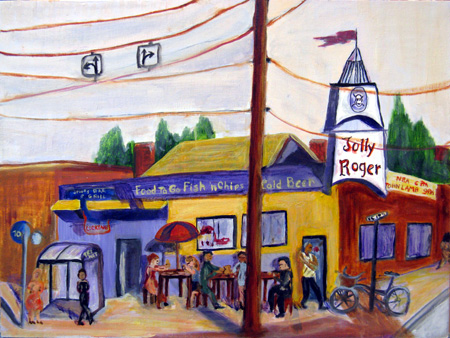


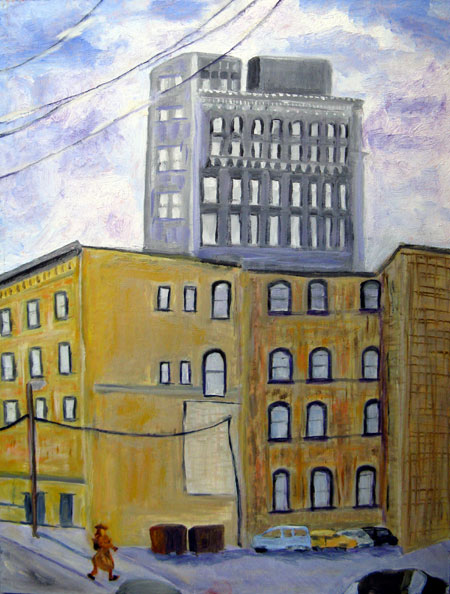
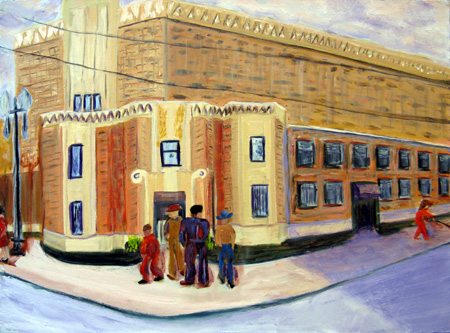

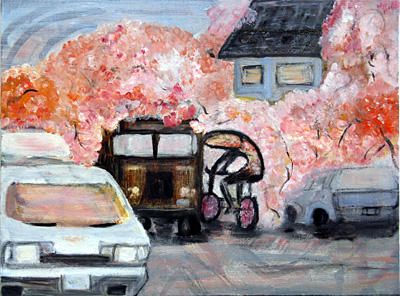
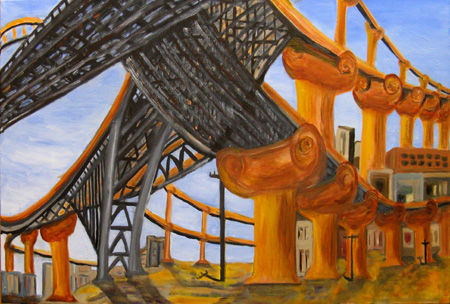

June,
I know you love to write, so I would never want to discourage you from doing so, but that said, your work needs no explanation. They speak for themselves.
Hopper with a joyous outlook?
Some of the joyousness seems due to the bright colors, some to the exuberant gesture like the rollicking overpasses, some to the humorous “bits” like the bicyclist head-butting a truck. I especially liked the boogie-woogie of the studio re-imagining of SE 6th and Alder. Portland better be a happy place for you, or your sense of it is not coming through.
D.
Thanks for the compliment(s). It’s perceptive of you to see the “explanation” side of this particular post; I was preparing to write an exhibit proposal and used AandP as a kind of warm-up.
That said, however, I think when people first come upon the city-scapes, they tend to be skeptical — the paintings appear faux naive, or some such. After a while, I have found, people who’ve looked often enough simply say, “ah, that’s our June.” I never quite know how to take that kind of comment so I assume it’s a compliment. add snort here.
Thanks for checking in.
Birgit,
I don’t mind being put in the bin with Hopper — and maybe as the rains come along, I’ll find myself putting on some of his somber moods. I can already see myself, huddled in the rain outside the Starbucks or Peets, tracking the denizens inside.
Painting plein air in Portland generally means sunny days in the summer because the drizzling days of winter are too miserable. That said, I now have a painting buddy who is younger as well as equally eager to get out (we think we need the Vitamin D), so we have been braving the elements. There are lots of bridges and interstate overhangs to shelter within — and the weather hasn’t been all that bad–yet.
In mood, the opposite of Hopper.
June,
Like Golf, Painting simply and unavoidably reveals who we really are.
The joy of finding the errant shot in the woods is too often tempered by the Tree that stands in the way.
Your paintings help us get around it.
(http://www.leewalton.com/projects/shot_a_day/shot4.html)
June:
Better than being thrown in a hopper with Bin. I would imagine that he would have some choice things to say about your making graven images.
Allow me to take a contrarian stance. D says that your paintings stand alone, which is true. But I enjoy the “everywhere I go, there I am” quality of your adventures. Every painting is an encounter with a formal motif, but that isn’t all.There’s the atmosphere, the scene, the people, the delight in the history of the place, the capturing, the painting, as it were, with a butterfly net. Then there’s the June Underwoodiness of it – a human landscape onto itself – that, together with all else makes for great narrative. Frostbitten in a parka, trying to get down the town dog in a rundown mining hamlet – that’s where it’s at, and deserves to take its place in the scheme. Title your book “Big Art in Small Places”.
June:
Trying to get (take) down the top dog in a rundown mining town. Is that better?
Sorry about the hopper bin. He happens to be one of my heroes.
Jay and Birgit —
Jay, I should have known you’d catch my feeble raising of the lid of the bin (there I go again….)
Birgit, Hopper is perhaps too heroic to be subject to bad puns. I’m blaming my attempts on Jay, who clearly is the top dog in this takedown.
A book about Hopper occupies prime space in my studio, which I allow very few books to inhabit. He too has a wonky, if more somber, perspective sometimes– I’m thinking of his farmhouse by the railroad tracks. I plan, when things settle down, to approach simplifying some of my ideas as he does so beautifully. In short, he is one of my heroes too.
I just want the art and
“Bloomtime” is crazy magnificent.